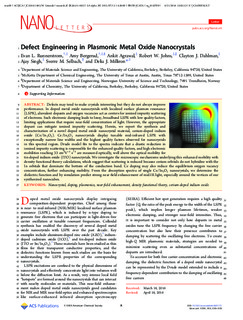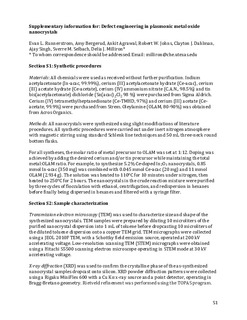| dc.contributor.author | Runnerstom, Evan J | |
| dc.contributor.author | Bergerud, Amy | |
| dc.contributor.author | Agrawal, Ankit | |
| dc.contributor.author | Johns, Robert W. | |
| dc.contributor.author | Dahlman, Clayton J. | |
| dc.contributor.author | Singh, Ajay | |
| dc.contributor.author | Selbach, Sverre Magnus | |
| dc.contributor.author | Milliron, Delia J. | |
| dc.date.accessioned | 2017-09-05T07:22:35Z | |
| dc.date.available | 2017-09-05T07:22:35Z | |
| dc.date.created | 2016-08-25T03:43:56Z | |
| dc.date.issued | 2016 | |
| dc.identifier.citation | Nano letters (Print). 2016, 16 3390-3398. | nb_NO |
| dc.identifier.issn | 1530-6984 | |
| dc.identifier.uri | http://hdl.handle.net/11250/2453122 | |
| dc.description.abstract | Defects may tend to make crystals interesting but they do not always improve performance. In doped metal oxide nanocrystals with localized surface plasmon resonance (LSPR), aliovalent dopants and oxygen vacancies act as centers for ionized impurity scattering of electrons. Such electronic damping leads to lossy, broadband LSPR with low quality factors, limiting applications that require near-field concentration of light. However, the appropriate dopant can mitigate ionized impurity scattering. Herein, we report the synthesis and characterization of a novel doped metal oxide nanocrystal material, cerium-doped indium oxide (Ce:In2O3). Ce:In2O3 nanocrystals display tunable mid-infrared LSPR with exceptionally narrow line widths and the highest quality factors observed for nanocrystals in this spectral region. Drude model fits to the spectra indicate that a drastic reduction in ionized impurity scattering is responsible for the enhanced quality factors, and high electronic mobilities reaching 33 cm2V–1 s–1 are measured optically, well above the optical mobility for tin-doped indium oxide (ITO) nanocrystals. We investigate the microscopic mechanisms underlying this enhanced mobility with density functional theory calculations, which suggest that scattering is reduced because cerium orbitals do not hybridize with the In orbitals that dominate the bottom of the conduction band. Ce doping may also reduce the equilibrium oxygen vacancy concentration, further enhancing mobility. From the absorption spectra of single Ce:In2O3 nanocrystals, we determine the dielectric function and by simulation predict strong near-field enhancement of mid-IR light, especially around the vertices of our synthesized nanocubes. | nb_NO |
| dc.language.iso | eng | nb_NO |
| dc.publisher | American Chemical Society | nb_NO |
| dc.title | Defect Engineering in Plasmonic Metal Oxide Nanocrystals | nb_NO |
| dc.type | Journal article | nb_NO |
| dc.type | Peer reviewed | nb_NO |
| dc.description.version | acceptedVersion | nb_NO |
| dc.source.pagenumber | 3390-3398 | nb_NO |
| dc.source.volume | 16 | nb_NO |
| dc.source.journal | Nano letters (Print) | nb_NO |
| dc.identifier.doi | 10.1021/acs.nanolett.6b01171 | |
| dc.identifier.cristin | 1375316 | |
| dc.relation.project | Notur/NorStore: NN9264K | nb_NO |
| dc.description.localcode | Copyright © 2016 American Chemical Society. This is the authors' accepted and refereed manuscript to the article. | nb_NO |
| cristin.unitcode | 194,66,35,0 | |
| cristin.unitname | Institutt for materialteknologi | |
| cristin.ispublished | true | |
| cristin.fulltext | postprint | |
| cristin.qualitycode | 2 | |

